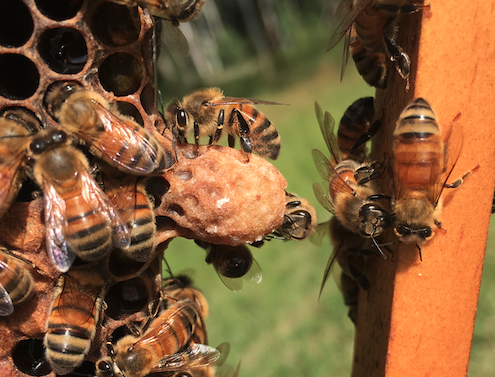
Like all animals, bees aim to reproduce. We might think that if the queen lays eggs and new bees emerge, the job is done.
But, when you consider what reproducing means for humans and other species, getting two different sets of DNA and producing a new being, a colony growing bigger does not quite qualify.
Swarming occurs when the conditions are good and/or the hive has run out of space, usually in spring and summer. The worker bees reduce the amount they feed the queen, and she stops laying and slims down so that she will be able to fly. (those pesky eggs do add up).
In the meantime, some scout bees start sassing out possible locations. They go into tree hollows, inside wall cavities, under roofs etc. They measure (how cool is that?) the space to make sure that it will be big enough.

In the hive, preparations are also underway, with the bees creating a few special cells to raise a new queen. These cells are larger and in the shape of a peanut and will accomodate the larger body of a queen.
When the time is right, the original queen will leave with half of the population to set up shop somewhere else. They sometimes hang out for a few hours or a few days off a branch until the scouts complete their reconnaissance mission. When they agree on where to go, they fly in a flurry of activity to their new home.
During this time, bees are usually very calm. They have no home or brood to defend, and their stomachs are full of honey in preparation for all the comb they will have to build from scratch.
In the original colony, the first new queen to emerge out of the cell will eliminate any competition because no one likes to share a crown.
She then will go on her maiden flight looking for suitable drones (male bees) to mate with.
Once she has successfully mated, she will return to the hive and start laying eggs after a few days.
Her offspring will bring new genetic traits to the hive.
The colonies where the drones came from also use this opportunity to pass on some of their DNA.
If you encounter a swarm and you would like to have it removed, your best bet is to contact a local beekeeper. If you live in NSW, the Amateur Beekeepers Association has a register of beekeepers that are available to collect swarms. You can find it here.
If you want to see a swarm we collected from our own front yard you can watch it below

Hello Sven and Ana, love learning from your little videos and commentaries!
Hope you make a good recovery Sven, and Ana from the shock of the accident. Do you live in NSW? I hope you have an outlet for selling your honey in Melbourne.
It is wonderful the way you care for bees and their healthy future. I’m not a bee keeper, but very aware of the environmental hazards facing insects and wildlife , and of course people!
Your humane, practical actions to remedy problems are inspiring. Thank you.